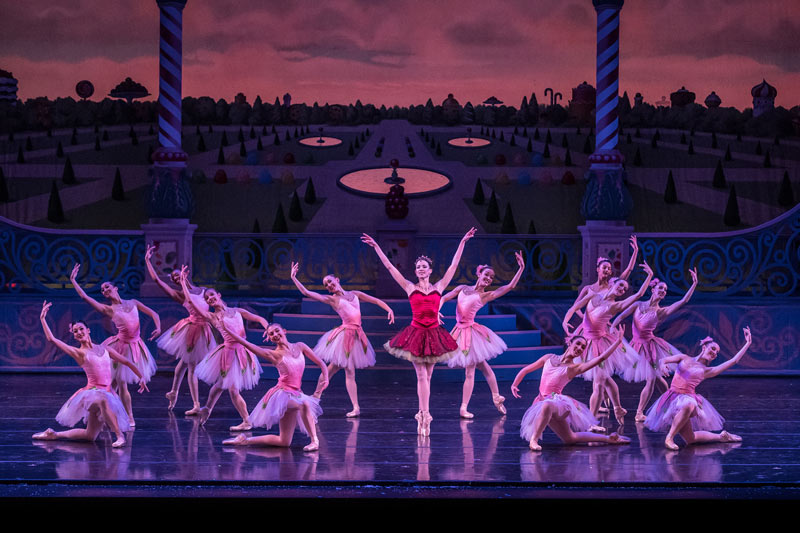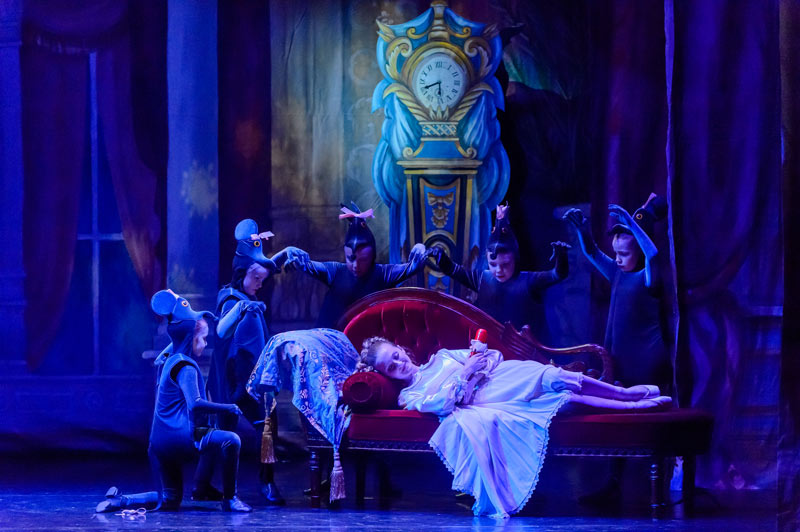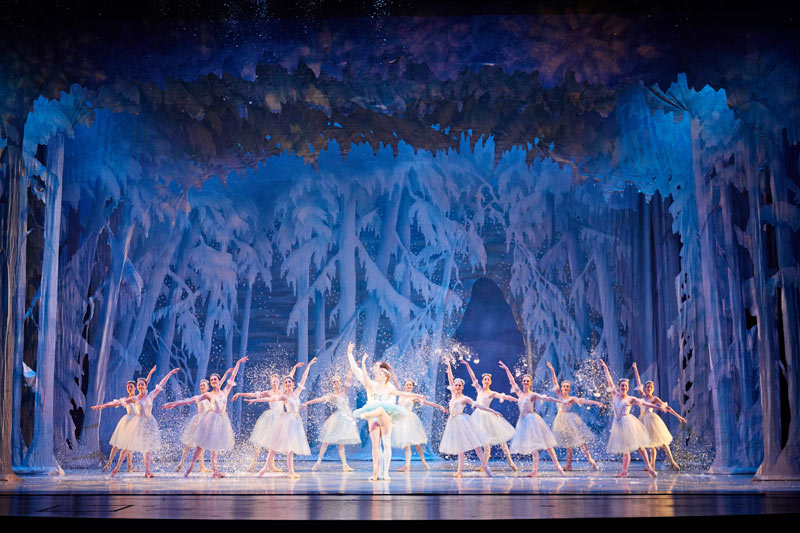The story starts with an incident that might happen in any family: a girl receives a Christmas gift from her godfather, and her jealous brother promptly breaks it. But that’s where the ordinary ends and the glorious spectacle of The Nutcracker begins. The ballet, which originated in Russia, follows young Clara’s journey as her beloved nutcracker figure springs to life to lead a gingerbread army against an invading force of mice. There’s a handsome prince, a soaring Tchaikovsky score, and a Sugar Plum Fairy; it’s no wonder The Nutcracker has become an essential part of the holiday season for families all over the world.
Local productions and traveling shows bring the iconic ballet to appreciative audiences here in Missouri. For professional ballet companies, The Nutcracker is often the most popular show of the season. Managers concerned with the practicalities of running a business know that this is the show that pays the bills, but it’s much more than that. Although their sets, costumes, and choreography vary greatly, the directors of ballet companies in St. Louis, Springfield, and Kansas City all agree on one thing: The Nutcracker is Christmas magic.
Kansas City Ballet
Clara and company traveled from Kansas City to Washington, DC, last year for seven sold-out performances of The Nutcracker at the Kennedy Center. The Washington Post raved about the Kansas City Ballet’s interpretation of the classic tale and said it was “positively oozing charm.”
The production owes that charm to artistic director Devon Carney’s vision.
“I take my view of The Nutcracker as going on this beautiful adventure through Clara’s eyes from start to finish, but it also has Dr. Drosselmeier (Clara’s mysterious godfather) very much involved because the whole story is about him giving this gift to her,” Devon says.
It’s a $2 million production, and Devon says, “You won’t find a show like that anywhere else in Missouri.”
Devon, who enjoyed a 21-year career as a dancer before making the leap to choreographer and artistic director, explains that choreographers have the freedom to be creative with the story and reimagine it … to a point.
“You can take some liberties with it, but the general story is there,” he says. “Some choreographers go way o the road map, and it can get confusing for audiences who are familiar with the story.”
Devon has found a way to follow that familiar roadmap in his choreography of The Nutcracker, while adding dazzling sights along the way, particularly in Act II, when much of the dancing takes place on one set.
“I’m very cognizant of our production entertaining a young audience,” he says. “If you don’t have those kids engaged, then it is difficult for the whole audience if the kids start getting antsy.”
To keep those short attention spans focused, every piece during the section of Act II known as the divertissement (which includes the Coffee, Chocolate, and Candy Cane dances, among others) incorporates a new element into the scene. The Candy Cane dance, for example, features Russian dancing so Devon added a line of 6-foot-tall matryoshka (nesting) dolls to the back of the stage. During the Chinese section of the performance, colorful lanterns fly in from overhead, and extras carry lanterns in on tall poles.
“You have a sense you are being transported,” Devon says.
Whether it’s the first show in the run or the last, Devon makes sure his dancers convey all the excitement and sense of wonder he remembers from his very first performance in The Nutcracker at age 15.
“Sixty percent of our audiences are new and a lot of people come to see ballet or our company for the first time,” Devon says. “I love the way it brings dance to new audiences on a daily basis.”
November 30–December 23 • Muriel Kau ffman Theatre, Kauff man Center for the Performing Arts • KCBallet.org
The Nutcracker in a Nutshell
The most successful ballet in history made a lackluster debut in St. Petersburg, Russia, in December 1892.
The Nutcracker was inspired by The Nutcracker and the Mouse King, a story by E.T.A. Homan. Homan’s fantasy was a dark and frightening tale, so when Imperial Russian Ballet choreographer Marius Petipa decided to adapt the story for the stage, he used Alexandre Dumas’s lighter, more audience-friendly version of the story.
Composer Pyotr Ilyich Tchaikovsky wrote the music for the ballet in 1891 while on tour in America. On his way back home to Russia, he stopped in Paris and encountered an instrument called the celesta. He was taken with the instrument’s sweet, bell-like sound and made it the signature “voice” of the Sugar Plum Fairy.
Even with Tchaikovsky’s stellar Nutcracker Suite and a charming story about a girl, a brave nutcracker, and a wicked mouse, the debut performance of e Nutcracker was underwhelming. Tchaikovsky himself described it as boring. Much of the blame fell to an assistant choreographer who was pressed into service when Petipa became ill and a Sugar Plum Fairy who was plumb awful.
The ballet enjoyed modest success in Europe but didn’t make its way to the United States until a Christmas Eve 1944 performance by the San Francisco Ballet. Ten years later, renowned choreographer George Balanchine put his stamp on e Nutcracker for the New York City Ballet. Finally, 52 years after its debut, e Nutcracker was a smash hit and has since become a holiday season staple for ballet companies all over the world.
Springfield Ballet
The Nutcracker has been an annual tradition for the dancers of Springfield Ballet since 1985, and an important training opportunity for the students this preprofessional organization serves.
Artistic and school director Ashley Paige Romines says that, with the exception of the roles of the Sugar Plum Fairy and her Cavalier, all other roles are filled by students or members of the community. “For the past few years, we have had right around 100 children performing,” she says.
Ashley Paige and other members of Springfield Ballet’s artistic staff have developed the choreography for the show. To keep the production interesting for the returning dancers and the audience, her team freshens up sections of the choreography each year. However, “there are certain sections that are staples and we don’t change,” she says.
Springfield Ballet’s interpretation of the story is uniquely Springfield, thanks to set designs by New England-based designer Roger LeVoie, who visited the region in 2016.
“Our snow backdrop especially and our house are Ozarks themes,” Ashley Paige says. “The house that you see is a very Ozark Victorian house that looks like it belongs on the street the theater is on. The snow scene is a frozen Ozarks waterfall.”
Keeping a cast of 100 outfitted in costumes can be a challenge, and Ashley Paige says her organization has volunteers and parents to thank for making sure the costumes fit properly. “We have very kind volunteers that we love very much who help us out with that,” she says.
The Nutcracker has earned its beloved status, according to Ashley Paige, because it is available to everyone. “People grow up hearing about it,” she says. “Ever since Balanchine’s version was televised in the 1950s, it became accessible to anyone of any background, not just for the elite who could see the live performance. Today, ballet companies do The Nutcracker to try to reach as many people as possible of all different backgrounds.”
Springfield Ballet’s outreach extends to local schools. Each year the company performs Act II for the city’s second-graders. “For a lot of them, it’s their first theatrical experience,” Ashley Paige says. Perhaps among those second-graders is a future Sugar Plum Fairy, waiting for her day in the spotlight.
December 14–17 • Landers Theatre • SpringfieldBallet.org
Growing Up With The Nutrcracker
The Nutcracker is more than just a beloved Christmas tradition for theatergoers. Every performance gives dozens of young performers an opportunity to share the stage with professional dancers. Most of these pintsized dancers and actors are getting their first exposure to the stage, and their Nutcracker experience can spark a passion that lasts a lifetime.
That’s what happened to Madelein Bailey, a college student who can trace her childhood through her roles in Th e Nutcracker. As a student with the Ibsen Dance Theatre in Kansas City, she has been a regular performer in the company’s biennial production of e Nutcracker since she was in second grade. As her ballet artistry grew, so did the roles she played. When she was in eighth grade, she won the role of Clara.
“In my sophomore year, I played the Dewdrop Fairy, and when I was a senior, I played the Snow Queen,” Madelein says.
Madelein has been dancing since she was 5 years old, but e Nutcracker has become something bigger than dance for her.
“The money that we raise from tickets goes to the Northland Christmas Store,” she says. “It’s special to me knowing the money is going to a great cause for families who don’t necessarily get to spend their Christmas like everyone else. Nutcracker is such a magical ballet, especially at Christmas time.”
For Madelein, that magic is more than just a nutcracker springing to life on stage. “It’s all about Clara’s dream,” she says. “It’s just a simple gift, the nutcracker, but it becomes something more for her. It shows the magic of Christmas that can get lost when you’re older and worrying about the kids getting Christmas presents.”
Madelein’s advice for children who are thinking about trying out for a role in e Nutcracker is this: “Every role is important. No matter how small the role is, you can make it whatever you want it to be. Even if you don’t get what you want the first time, keep trying and you’ll get there someday.”
Wise words from the Snow Queen herself.
Saint Louis Ballet
Saint Louis Ballet’s artistic director Gen Horiuchi knows something about keeping audiences entertained: he choreographed the opening ceremonies of the 1998 Winter Olympics in Nagano, Japan. Managing a Nutcracker cast of a hundred, many of whom are children performing on stage for the first time, doesn’t faze Gen.
“We have many, many volunteers working backstage,” he says. “Parents of the little students take turns. We do 13 performances this year, and it’s almost mandatory for the parents to help backstage.”
Those parents are happy to help, considering their youngsters get to perform with the talented professionals in the Saint Louis Ballet’s company.
Professional dancers from around the world come to St. Louis to vie for an opportunity to work with Gen in The Nutcracker and the company’s other productions. This is Gen’s 19th year producing The Nutcracker, and he makes certain the show undergoes a transformation each year.
“With a lot of major ballet companies, once they stage a production, they keep it the same for years to come,” he says. “But I always update or change it for the better each year. In today’s dance, audiences are used to watching the dance programs on TV with those amazing tricks here and there. Also, ballet technique improves each year. I implement today’s level of ballet technique into the production so people don’t get bored.”
The Saint Louis Ballet performs Gen’s own choreography for its version of The Nutcracker. Although he loves incorporating fresh ideas, he is conscious of tradition.
“I want to make it clear what is happening on stage,” he says. “Believe it or not, there are many Nutcrackers out there where it doesn’t make sense. They are so focused on the dancing and the choreography that the storytelling becomes secondary. I want to make sure my audience understands what is happening. Why is there a scene change? Why does the mouse show up?”
Gen’s own experience as a dancer makes him sensitive to his dancers’ needs for new challenges. “I did the Broadway musical Cats for 2,000 performances,” he says. “I like to find that ‘something different’ on stage in my performing. I never get tired of it. If something happens on stage accidentally and the audience reacts favorably, I keep an eye out for that and change it for the better.”
December 14–23 • Touhill Performing Arts Center • Touhill.org
The Man, The Mouth, The Legend
Decorative nutcrackers have been taking a bite out of the nut-cracking chore since the 15th century. The carved figures depicting soldiers, kings, and other characters originated in Germany, where they were regarded as good-luck tokens. The earliest versions of these nutcrackers were functional as well as decorative. Eventually, other, better tools came along to crack nuts, and the ornate, carved nutcrackers came to be viewed simply as decorative collectibles. The popularity of nutcrackers surged in the United States with the debut of The Nutcracker ballet in 1940.
Related Posts
Here’s Our Guide to Growing Native Plants
By landscaping with native Missouri plants, gardeners with the palest of green thumbs can enjoy such views just like the pros, all while knowing they’ve done their part to nurture complex ecosystems.
Your Guide to Food, Wine, & Sweets in Columbia
Wine, chocolate, barbecue … whatever fare you fancy, you’ll find it in Columbia. The city has attracted talented purveyors and restaurateurs who take pride in satisfying even the most particular palate. Here are just a few of the businesses that give the city its flavor.
Earthly Creations
They say that life is what happens while you’re busy making plans. We’re pretty sure you’d get no argument from Sandra Zak.





